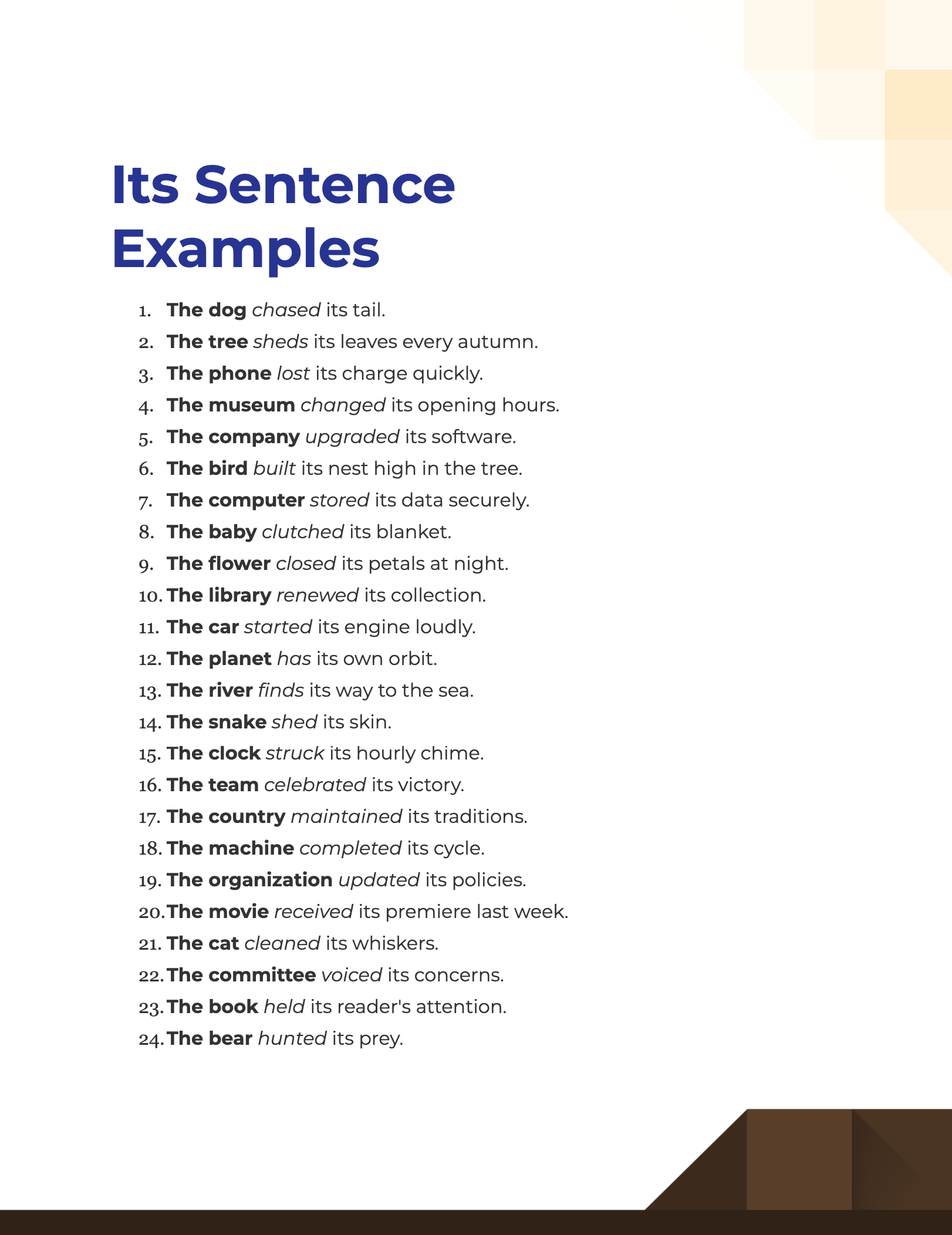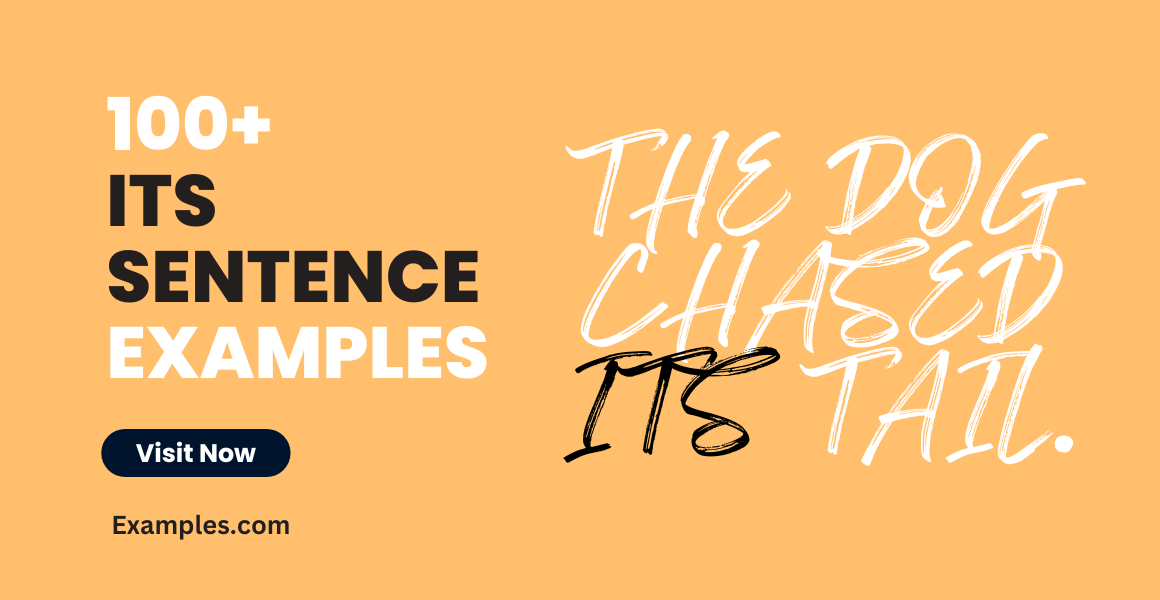99+ Its Sentence Examples
Delve into the realm of “its” sentences, a foundational aspect of English writing. Understanding the correct usage of “its” can amplify the clarity and effectiveness of your content. Here, we unravel its nuances, offer exemplary sentences, and provide invaluable tips to master its application.
What is the Its Sentence? – Definition
An “its sentence” refers to a sentence where the possessive form of the pronoun “it” is used. This form, “its,” is used to indicate possession and does not require an apostrophe, distinguishing it from “it’s,” which is a contraction of “it is” or “it has.”
What is the best Example of a Its Sentence?
Consider the sentence: “The cat licked its paw.” Here, “its” signifies the possession of the paw by the cat. The usage of “its” in this context showcases the possessive nature without implying any contraction or abbreviation, thus making it a clear and concise representation of an “its sentence.”
100 Its Sentence Examples

Incorporate the possessive “its” into your writing with finesse by exploring these illustrative examples. Understanding how “its” integrates seamlessly into varied sentences can enhance your linguistic prowess. Below, find 100 distinct and purposeful sentences showcasing “its” usage, emphasizing the subject in bold and the verb in italic for better clarity.
- The dog chased its tail.
- The tree sheds its leaves every autumn.
- The phone lost its charge quickly.
- The museum changed its opening hours.
- The company upgraded its software.
- The bird built its nest high in the tree.
- The computer stored its data securely.
- The baby clutched its blanket.
- The flower closed its petals at night.
- The library renewed its collection.
- The car started its engine loudly.
- The planet has its own orbit.
- The river finds its way to the sea.
- The snake shed its skin.
- The clock struck its hourly chime.
- The team celebrated its victory.
- The country maintained its traditions.
- The machine completed its cycle.
- The organization updated its policies.
- The movie received its premiere last week.
- The cat cleaned its whiskers.
- The committee voiced its concerns.
- The book held its reader’s attention.
- The bear hunted its prey.
- The city lit its skyline beautifully.
- The plant absorbed its nutrients.
- The artist expressed its vision vividly.
- The nation celebrated its independence.
- The child treasured its toy.
- The band launched its new album.
- The website updated its design.
- The ship set its course.
- The sun shone its brightest at noon.
- The school modified its rules.
- The elephant waved its trunk.
- The store advertised its sale.
- The magazine published its latest edition.
- The family enjoyed its vacation.
- The forest echoed its own silence.
- The orchestra tuned its instruments.
- The lion roared its dominance.
- The island had its own unique flora.
- The train sounded its horn.
- The cafe introduced its new menu.
- The turtle retracted its head.
- The hotel renovated its lobby.
- The bee pollinated its favored flowers.
- The brand expanded its range.
- The mountain towered its majestic peak.
- The classroom echoed its empty state.
- The cloud released its rain.
- The athlete broke its record.
- The camera captured its perfect shot.
- The stadium filled its seats.
- The ocean reflects its endless horizon.
- The festival showcased its cultural diversity.
- The project met its deadline.
- The novel revealed its twist.
- The deer grazed its favorite meadow.
- The agency implemented its new strategy.
- The farm harvested its crops.
- The bird sang its morning song.
- The market displayed its variety.
- The town held its annual fair.
- The conference announced its keynote speaker.
- The butterfly showed its colorful wings.
- The baker presented its best cake.
- The moon lit its crescent phase.
- The dragon spread its wings wide.
- The garden blossomed its spring colors.
- The cell divided its contents.
- The festival celebrated its 10th year.
- The writer published its memoir.
- The wind carried its scent.
- The lake mirrored its surroundings.
- The choir harmonized its voices.
- The desert revealed its beauty at sunset.
- The park opened its new playground.
- The TV displayed its high-resolution picture.
- The forest protected its inhabitants.
- The bakery sold its famous pastries.
- The agency announced its merger.
- The scientist published its findings.
- The zoo introduced its new inhabitants.
- The storm unleashed its fury.
- The bakery introduced its gluten-free line.
- The watch showed its precise time.
- The farmer milked its cow.
- The rainbow displayed its colors.
- The university awarded its top students.
- The airplane landed its smooth descent.
- The actor won its first Oscar.
- The play received its standing ovation.
- The machine produced its item.
- The apple showed its ripe color.
- The engine roared its power.
- The robot executed its task.
- The galaxy contained its billions of stars.
- The stadium echoed its roaring crowd.
- The diary held its treasured memories.
How do you use its in a sentence?
Using “its” in a sentence can enhance the clarity and accuracy of your writing. As the possessive form of “it,” “its” signifies possession or attribution to something previously mentioned or understood. Here’s how to use it:
- Determine if Possession is Involved: Before using “its,” ensure that the sentence requires a possessive pronoun. This means that one thing belongs to or is a part of something else.
- Correct: The dog wagged its tail.
- Incorrect: The dog is chasing it’s ball.
- Avoid the Apostrophe: Unlike other possessive forms, “its” doesn’t require an apostrophe. This is a common mistake because possessive nouns usually do. Remember, “it’s” is a contraction for “it is” or “it has.”
- Correct: The bird fluffed up its feathers.
- Incorrect: The bird fluffed up it’s feathers.
- Context Matters: Ensure the subject in question is clear to avoid any confusion.
- Example: The magazine featured the camera and its advanced features.
Where do we use its?
The usage of “its” is pivotal in English grammar, primarily emphasizing possession. Here are situations where “its” is appropriately used:
- Inanimate Objects: To denote possession when the object is non-living.
- Example: The table has lost its shine.
- Animals: When talking about animals whose gender is unknown or when it’s unnecessary to specify the gender.
- Example: The cat licked its paw.
- Abstract Ideas or Concepts: When referring to institutions, entities, or concepts.
- Example: The company increased its prices.
- Natural Elements: When discussing natural phenomena or elements.
- Example: The earth has its natural cycles.
What does its mean in a sentence?
In the labyrinth of English grammar, “its” plays a crucial role as a possessive adjective. In a sentence, “its” denotes:
- Possession: Signifying that something belongs to or is associated with something.
- Example: The flower has lost its fragrance.
- Attribution: Indicating a particular quality or feature of something.
- Example: The novel is famous for its intriguing plot.
- Part-whole Relationship: Highlighting that something is a part or component of something bigger.
- Example: The car needs its tire changed.
Understanding the function of “its” can significantly augment the accuracy and fluidity of your prose, making your writing both precise and reader-friendly.
How do you write Its Sentences? – Step by Step Guide
Crafting sentences with the possessive pronoun “its” can be smooth sailing once you understand its nuances. Follow this step-by-step guide to effortlessly integrate “its” into your writing:
- Identify the Subject: Begin by pinpointing the subject or entity in your sentence that will possess something or have something attributed to it.
- Potential Subject: tree
- Determine the Possession: Recognize the attribute or possession you want to associate with your subject.
- Possession: leaves
- Frame the Basic Sentence: Construct a basic sentence without worrying about the possessive aspect.
- Basic Sentence: The tree has leaves.
- Incorporate “Its”: Replace the direct association with “its” to indicate possession.
- Its Sentence: The tree sheds its leaves.
- Avoid Confusion with “It’s”: Always remember that “its” denotes possession, while “it’s” is a contraction for “it is” or “it has.”
- Incorrect: The tree sheds it’s leaves.
- Correct: The tree sheds its leaves.
- Review for Clarity: Ensure your sentence is clear and the reference of “its” is unmistakable.
- Clear: The book lost its cover.
- Unclear: The book and magazine were damaged, and it lost its cover.
Tips for Using Its Sentences
Harnessing the power of “its” in your sentences can enhance your content. Here are some golden tips to ensure you’re using “its” optimally:
- Context is Key: Always ensure the antecedent of “its” is clear to avoid ambiguity.
- Ambiguous: The chair and table were kept outside, and its color faded.
- Clear: The chair was kept outside, and its color faded.
- Avoid Overuse: While “its” is a helpful tool, using it excessively can make your writing repetitive. Try rephrasing occasionally.
- Repetitive: The cat cleaned its fur, chased its tail, and licked its paws.
- Improved: The cat cleaned its fur, chased its tail, and then gave attention to its paws.
- Contrast with “It’s”: Regularly review your content to ensure you haven’t confused “its” with “it’s.” This is a common pitfall even for seasoned writers.
- Keep It Simple: Especially when writing for a broader audience, maintain clarity. Overcomplicated sentences can lose the reader.
- Overcomplicated: The laptop, which was given to me last year on my birthday by my uncle from Texas, has lost its charger.
- Simplified: The laptop my uncle gave me last year has lost its charger.
- Pair with Descriptive Elements: Enhance the effectiveness of “its” by adding descriptive adjectives or phrases.
- Basic: The bird built its nest.
- Descriptive: The bird built its intricate, twig-laden nest.
With these steps and tips, you’re well on your way to mastering the art of crafting impactful “its” sentences.



